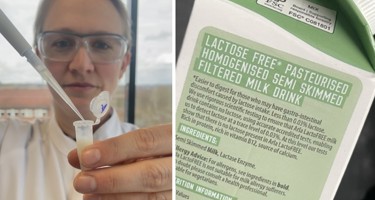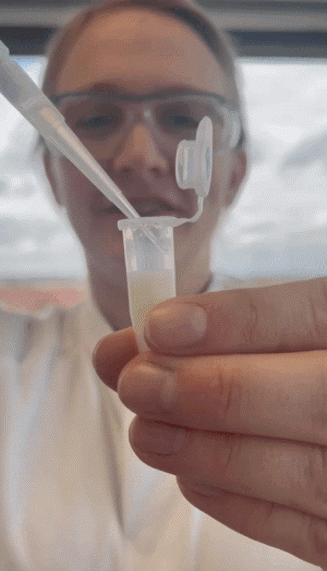
If you’ve tried lactose free dairy products you may have noticed that some of them taste a little sweeter than regular dairy products. But why is that? What is the difference between lactose free milk and regular milk? And how is lactose free milk made?
We’ve teamed up with our two Research Scientists, Valentin Rauh and Signe Munk Rydtoft. They both specialise in dairy enzymes and how these affect the taste profile of dairy products.
In this article, you will learn what the enzyme called lactase has to do with the sweet taste of lactose free milk, and how we in Arla have found a way to produce lactose free milk without the sweet taste.
The chemistry behind the sweet taste of lactose free
To understand why some lactose free milk products taste sweeter than regular milk, we first need to understand the role of enzymes.
Similar to bacteria, enzymes are part of all of us and everything that surrounds us. They are tiny-tiny proteins that naturally help speed up chemical reactions in all living cells. In our bodies, they play a crucial role in breaking down food to make it possible for the body to obtain nutrients and energy from it.
One particular enzyme, called lactase, plays a critical role in the digestion of lactose, a sugar naturally found in milk and dairy products. There are some people who do not produce the lactase enzyme, which means the body is not able to digest lactose properly. This is when lactose intolerance occurs.
Luckily, the food industry has found a way to “pre-digest” the milk, to make sure that people with lactose intolerance can still enjoy the benefits of dairy products.
This happens by adding natural lactase enzymes to the milk.
The lactase enzymes are by nature “programmed” to find the lactose molecules in the milk. When they’ve found them they will split the lactose into two simpler components called glucose and galactose, which are easy for the body to absorb and obtain energy from. The lactase enzymes added to the milk are the same as those the body uses to break down lactose in the intestine, so the process is all natural and equivalent to what happens in the body.
Coming back to our initial question, it is from this process that the sweet taste in lactose free milk arises. You’ve probably heard about “glucose” before? Like in “glucose syrup”?
In this case, it has nothing to do with syrup, confectionary or bakery! Glucose and galactose are other types of sugar, which after adding lactase enzymes will now occur in the milk. Compared to lactose, glucose and galactose have a much sweeter taste.
After going through this process, lactose free milk will therefore taste, to be exact, 3.2 times sweeter than regular milk.
Dairy Research Scientist, Signe Munk Rydtoft explains how it works in this video:
How we make lactose free milk without the sweet taste
In Arla, we have found that the majority of consumers, in Scandinavia in particular, prefer to consume milk that does not have a sweet taste. Many tend to avoid lactose free milk because it tastes too sweet compared to regular milk. For families with a member who is lactose intolerant, this might mean that they have to buy two different milk products to meet everybody’s needs and tastebuds.
But wouldn’t it be nice if they didn’t have to?
We wanted to offer lactose free milk that was as close to regular milk as possible, preserving its original taste and nutritional value as much as possible. Back in 2007, we therefore developed and finetuned the technology that enables us to produce lactose free milk at most of our dairies. Using a special filtration technique, we can produce lactose free milk that is almost identical to regular milk in terms of taste and nutrients.
In this video, Senior Researcher Valentin Rauh explains how the process works:
By filtering the milk and removing almost half of the lactose before adding the lactase enzyme, the sweet taste that will come from the glucose and galactose will be so limited that most people can’t taste the difference. The level of carbohydrates is slightly reduced as a consequence of the filtering process, but the levels of calcium and protein, for example, are roughly the same.
Read more about the nutrients in milk here.
Enzymes are important components in product innovation
In Arla, we work with natural enzymes every single day, not only because they surround us all, but because they are crucial to ensuring and optimising the quality of dairy products.
A part of Signe’s job description is to identify enzyme solutions for the future. In the video below, she is adding a particular type of lactase enzyme to a milk sample to test its level of activity.

All the enzymes we use in Arla are derived from nature, there is nothing synthetic about them. But different enzymes behave differently depending on the environment they are put in.
We work in close collaboration with universities, ingredient partners and startups to understand which enzymes that can help create products of the future. For example, which enzymes contribute to the best texture, mouthfeel and taste in oat drinks for our plant based brand JÖRD. Or the best-in-class lactase enzymes that operate at a certain temperature or a certain PH-level to optimise the production and create the best lactose free yogurt.
About

Valentin Rauh has a PhD in Food Science from the Technical University of Munich and has 12 years of experience working with dairy chemistry and aroma chemistry. He is Senior Research Scientist in Arla Foods and has run several research projects on lactose free dairy, UHT milk and shelf-life in collaboration with different Universities.
Signe Munk Rydtoft has a master’s degree in Molecular Nutrition and Food Technology and 9 years of experience. She is Research Scientist in Arla Foods and specialises in Enzyme application.